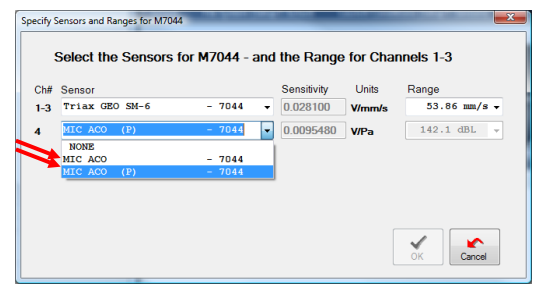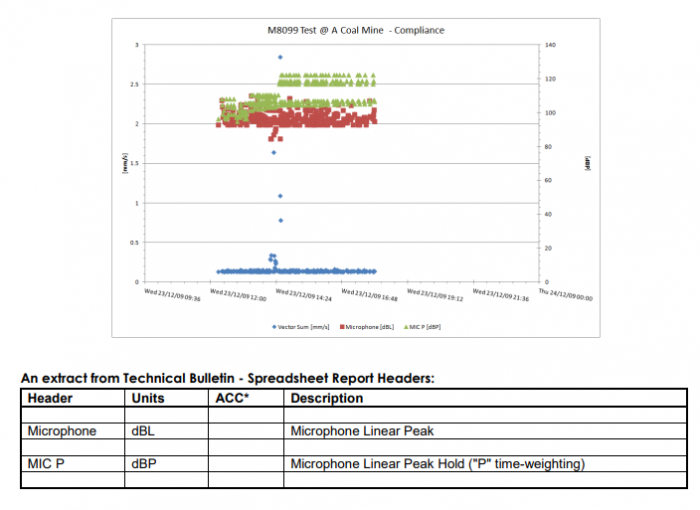Monitor Compliance with Peak Hold specification in AS1259.1
Background
Western Australia’s ‘Environmental Protection (Noise) Regulations 1997’ refer to AS 1259.1-1990 under
‘Airblast levels due to blasting’.
The Queensland EPA’s Guideline ‘Noise and vibration from blasting’ also refers to compliance with
AS1259.1-1990.
Both of these documents refer to the “Linear Peak” as obtained using the “P” time-weighting
characteristic. The QLD EPA Guideline also refers to a ‘detector onset time … in accordance with AS1259.1 clauses 8.5 and 10.4.
This Technical Bulletin explains how Texcel Monitors comply with all of these regulations.
Texcel Microphone – Linear and Peak Detect
Original Compliance with AS2187 – dBL
Texcel’s monitors were originally designed to comply with AS2187, and delivered a Linear dB result –
achieving a ‘flat’ response down to 2 Hz. This flat response is identical to the “Z” frequency weighting
characteristic as specified in AS IEC 61672.1-2004, or to what is sometimes referred to as “with all
frequency-weighted networks inoperative”.
■ Texcel’s system uses the unit dBL for this result.
Achieving the “P” Weighting of AS 1259 as well – dBP
Texcel’s ETM and GTM monitors have the ability to capture the ‘transient peak’ referred
to as “P” time-weighting characteristic as specified in AS1259.1-1990. The monitors also comply with “a
detector onset time of not greater than 100 microseconds as assessed in accordance with AS –1259.1-
1990 clauses 8.5 and 10.4.”
■ Texcel’s system uses the unit dBP for this result.
To Summarise – Texcel’s monitors report two separate results for the microphone!
■ dBL means ‘dB Linear’ in terms of AS2187 and means ‘flat weighting down to 2Hz’.
■ dBP means ‘dB Peak Detect or “P” Time Weighted as specified in AS1259
By default the Texcel Monitor will report both of these results.
The results are reported in both the Blast Report and the Spreadsheet Reports available from T-Link.
How the settings control the visibility of dBP
In custom settings sensors selection, a monitor with a Peak Detect Microphone sensor will present the
Microphone on the sensor twice:

■ Select MIC ACO (P) to enable dBP Results
■ Select MIC ACO to disable dBP results.
If you use Texcel Settings, the Peak Detect Microphone sensor will be automatically selected, so that
both results are available on reports.
You can also ask Texcel to prepare the monitor without the Peak Detect Microphone available.
dBL and dBP results in the Blast Report
The results section of T-Link’s Blast Report starts like this:

dBL and dBP results in the SpreadSheet

The Actual Texts in the Regulations
Texcel’s ETM and GTM Monitors with Peak Detect enabled as above comply with all of these statements:
Western Australia’s Environmental Protection (Noise) Regulations 1997:
Being used for airblast measurements, Texcel equipment falls under Clause 5 of Schedule 4 – “Instrument
used for measurement of airblast levels”.
Sub-clause (1) of Clause 5 refers to Regulation 11, which references AS1259.1 in the following way:
(1) In this regulation —
“airblast level” means a noise level resulting from blasting;
“L Linear peak” means the maximum reading in decibels (dB)obtained using the “P” time-weighting characteristic as specified in AS 1259.1-1990 with all frequency-weighting networks inoperative
Queensland EPA’s Guideline ‘Noise and vibration from blasting’
Under Measurement States:
Noise from blasting shall be measured using noise measurement equipment with a lower limiting
frequency of 2Hz (- 3dB response point of the measurement system) and a detector onset time of not
greater than 100 microseconds as assessed in accordance with AS –1259.1 clauses 8.5 and 10.4.
And in Glossary of Terms:
dB (linear) peak is the maximum reading in decibels (dB) obtained using the “P” time – weighting
characteristic as specified in AS 1259.1 – 1990 with all frequency-weighted networks inoperative.
An extract from 8.5 of 1259.1
NOTE: For other types, the onset time should be such that a single pulse of either polarity of 100µs
duration produces a deflection of no more than 2dB below the deflection produced by a pulse having
a duration of 10ms and equal amplitude.
In 10.4 it ‘defines’ onset time:
The onset time of the peak detector shall be determined by comparing the response of a short-duration
rectangular pulse with that for a pulse of 10ms duration. The onset time to be specified by the
manufacturer is equal to the duration of the pulse that produces an indication 2dB below that of the
10ms reference pulse.
Further Assistance
If you need any further assistance, please contact Texcel:
Phone: +61-7-3237 8111
Email: team@texcel.com.au
